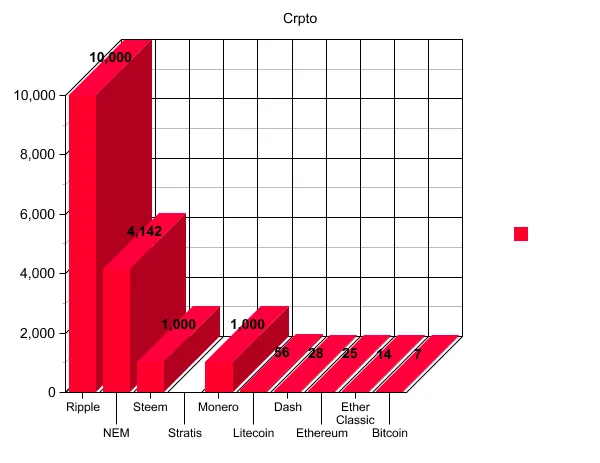
Bitcoins biggest weakness, the systems "limited capacity" has also increased demand for crypto-currencies. Its developers have argued for years about how to expand the system, which can only handle seven transactions per second, compared with thousands on conventional payment services. Even before worries surfaced that the currency could split in two over the disagreement, bitcoin holders started to diversify into some of the many other crypto-currencies, or altcoins, to emerge in recent years...Although it is still the biggest kid on the blockchain and functions, in effect, as a crypto-reserve currency, it now makes up under half the combined market capitalisation of all crypto-currencies.
First
Ripple built their own Payment Channel specifically designed for XRP, the digital asset native to RCL. An XRP Payment Channel allows transaction throughput to increase to tens of thousands of transactions per second, bringing our scalability to the same level as Visa.
Second
The Steem platform is built upon Graphene, the same technology that powers BitShares, another blockchain network created by Dan Larimer, also a co-founder of Steem and Steemit with Ned Scott. This technology has been demonstrated sustaining over 1,000 transactions per second on a distributed test network and can easily scale to 10,000 or more.
Third
NEM/XEM An application was written to sequence the transactions in a series of constant stream of transactions from each of the 10.8 million accounts. The results obtained were very encouraging. The average transaction rate came to 3,085.77 tps completing the experiment in just under an hour. It hit a peak of 4,142 tps.
Fourth
Stratis will have an official visual block explorer and API that should be able to support up to 20,000 requests per second.
Fifth
Monero already has a dynamic block size. Theoretically, nodes could, if the bandwith allowed it, handle over 1000 transactions per second with modern hardware.
Sixth
Litecoin has a maximum capacity of 56 tx/second. Lightning would increase this speed significantly.
Seventh
Dash has a current limitation of 28 tx/second. A change to 2MB block size limitation, would allow up to 56 tx/second.
Eighth
Ethereum is fundamentally limited by single threaded performance of a CPU. Discussion over GAS costs/etc is misleading because the maximum GAS that an individual node can process is limited and there is relatively little room to optimize execution.Early test networks reached 25 tx/second. With optimizations they may be able to reach 50 tx/second. Ethereum scalability improvements (PoS and Sharding) up to 30,000 tc/second.
Ninth
Ethereum Classic has a maximum capacity of 14 tx/second per second.
Tenth
Bitcoin is limited to 3 tx/second by an artificial block size which could be increased to 100 tx/second without running into the CPU limit. 10 minute block times. Bitcoin scalability improvements (Segwit and Lightening network) up to 50,000 tx/second.
If you are active in the Bitcoin world today you will definitely know about the Bitcoin SegWit debate and conflict in the community. Everyone in the community is noticing that the Bitcoin fees are going up and transactions are not getting confirmations quickly as the blocks become full. There is generally no debate that Bitcoin needs to be scaled so that it can handle more transactions per second, the only question is how do we do that?
Today we arguably have two realistic solutions for the scaling issue; Bitcoin Unlimited or SegWit (either miner activated or user activated). The majority seem to be behind the softfork (and less risky) SegWit activation that from what I can tell would allow nearly double the amount of transactions that could occur in each block. This would mean we would be able to send more Bitcoin transactions per second and likely at a cheaper cost (plus some other positive technical changes). Bitcoin Unlimited is a hardfork (non reversible change) leaving the blocks open to change by the miners so that all transactions can fit into blocks.
With the current blocksize limit of 1MB it is very clearly being tested at the moment.
